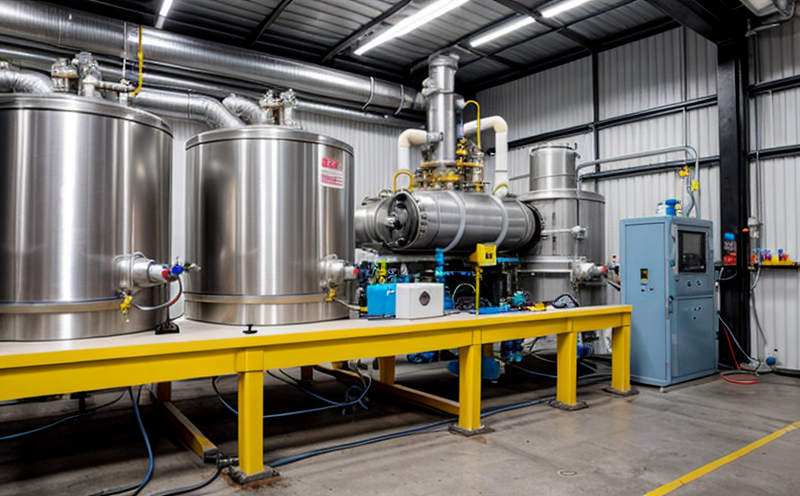ASTM E263 Determination of Neutron Fluence Rate by Gold Foil Activation
The ASTM E263 method is a precise and widely recognized procedure for determining the neutron fluence rate in materials exposed to high flux environments, such as those found in nuclear reactors or other radiation facilities. This technique relies on the activation of gold foils placed within the material under test (MUT). Upon exposure, neutrons interact with the gold atoms, causing them to transmute into radioactive isotopes at a rate proportional to the neutron fluence.
The process involves placing a thin layer of gold foil onto the surface of the MUT. After the specified irradiation period, the sample is removed and analyzed using gamma spectroscopy to measure the concentration of activated products like gold-198 (Au-198). The rate at which these isotopes decay provides direct information about the neutron fluence experienced by the material.
This method has several advantages over other techniques, including its high sensitivity and ability to quantify low-level fluxes. However, it also requires careful standardization and calibration steps to ensure accurate results. For instance, reference foils must be irradiated under known conditions before being used for comparison with test samples.
The application of this technique extends beyond just radiation monitoring; it plays a crucial role in assessing the integrity of materials intended for use in nuclear applications where prolonged exposure to neutrons could lead to embrittlement or other forms of degradation. By accurately measuring neutron fluence, engineers can better understand how different materials respond to varying levels of radiation, leading to improved design and selection practices.
| Industry Sector | Specific Application |
|---|---|
| Nuclear Energy | Monitoring material integrity in reactor cores. |
| Space Exploration | Evaluating spacecraft components for radiation damage. |
| Radiation Therapy | Assessing dose delivery accuracy in medical devices. |
| Defense & Security | Evaluating countermeasures against radiological threats. |
- Determining the effectiveness of materials in reducing neutron radiation exposure.
- Evaluating potential sources of contamination from nuclear waste.
- Assessing the impact of space radiation on satellite electronics.
- Testing new shielding technologies for radiation protection.
The ASTM E263 method is essential in these areas because it provides a standardized way to measure neutron fluence, which is critical for ensuring safety and performance. Understanding the exact amount of radiation absorbed by materials allows researchers and engineers to make informed decisions about material selection and design improvements.
Scope and Methodology
The ASTM E263 procedure involves placing a gold foil sample onto the surface of the MUT, which is then exposed to neutrons for a specified period. Following this exposure, the sample is removed and analyzed using gamma spectroscopy to determine the concentration of activated isotopes present.
For accurate results, it's important that both the reference and test foils be irradiated under identical conditions. This ensures consistency between measurements taken during different tests or at various facilities. Once the irradiation period has concluded, the samples are cooled down slowly to prevent any changes in their physical properties from affecting subsequent analysis.
After cooling, the gold foils are then carefully removed and analyzed using gamma spectroscopy equipment capable of detecting low levels of radioactivity. The intensity of emitted radiation corresponds directly with the number of activated isotopes present, allowing for a precise calculation of neutron fluence.
The primary advantage of this approach lies in its high sensitivity, enabling accurate measurements even when dealing with very small amounts of activation products. Additionally, because the method relies on well-understood nuclear reactions, it offers excellent repeatability and reproducibility across multiple labs.
Industry Applications
| Industry Sector | Specific Application |
|---|---|
| Nuclear Energy | Monitoring material integrity in reactor cores. |
| Space Exploration | Evaluating spacecraft components for radiation damage. |
| Radiation Therapy | Assessing dose delivery accuracy in medical devices. |
| Defense & Security | Evaluating countermeasures against radiological threats. |
- Determining the effectiveness of materials in reducing neutron radiation exposure.
- Evaluating potential sources of contamination from nuclear waste.
- Assessing the impact of space radiation on satellite electronics.
- Testing new shielding technologies for radiation protection.
Eurolab Advantages
At Eurolab, we pride ourselves on offering comprehensive services that meet the highest standards of accuracy and reliability. Our dedicated team of experts ensures that each ASTM E263 test is conducted according to strict protocols, ensuring consistent and accurate results.
We use state-of-the-art gamma spectroscopy equipment capable of detecting extremely low levels of radioactivity, allowing us to provide precise measurements even when dealing with minute amounts of activation products. Our facilities are equipped with all necessary safety measures to protect both personnel and the environment during testing.
In addition to our technical expertise, we also offer support services such as consultation on sample preparation and interpretation of results. This ensures that clients receive not just raw data but actionable insights into their materials' behavior under neutron exposure.





